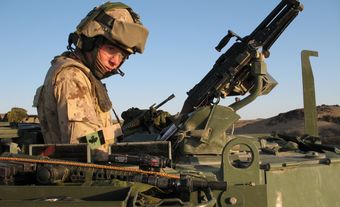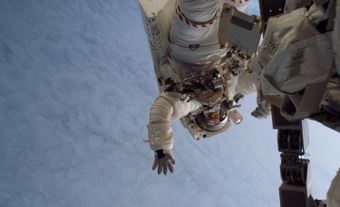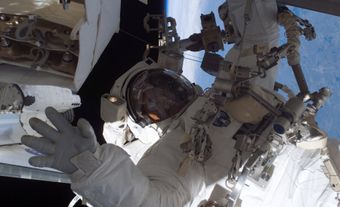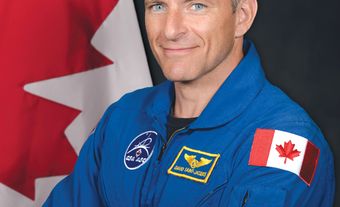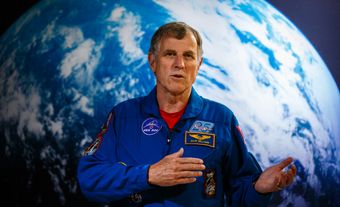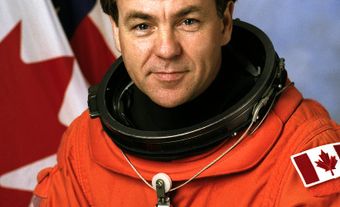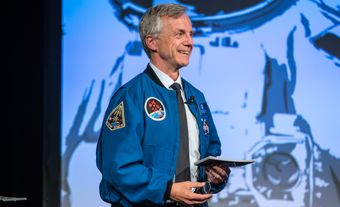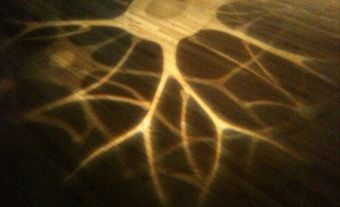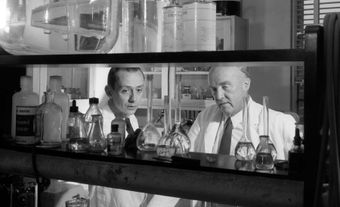Chris Austin Hadfield, OC, OOnt, astronaut, military test pilot (born 29 August 1959 in Sarnia, ON). After a distinguished career as a test pilot, Hadfield became an astronaut in 1992. Over the course of his career, he achieved a series of Canadian firsts: he was the first Canadian to be a space mission specialist, to operate the Canadarm in orbit, to do a spacewalk and to command the International Space Station. He was also the first to record a music video in space — a cover of David Bowie’s “Space Oddity” — adding to his celebrity status. Hadfield retired from the Canadian Astronaut Corps in July 2013. In 2014, he began teaching in the University of Waterloo’s aviation program.
Education and Early Career
Chris Hadfield graduated from Milton District High School in 1977. He had flight in his blood from an early age: his father, Roger, was a pilot with Air Canada and also flew his own aerobatic plane. Chris and his brothers, David and Philip, were air cadets. His brothers went on to become airline pilots. Hadfield opted for the military, graduating in 1982 from the Royal Military College in Kingston, Ontario, with a degree in mechanical engineering.
Hadfield’s distinguished career as a pilot began with three years flying CF-18s with the Canadian Forces in Quebec. In 1985, he became the first CF-18 pilot to intercept a Soviet “Bear” aircraft in Canadian airspace (see Stories of Remembrance: Chris Hadfield). Next, he attended the United States Air Force Test Pilot School in California, where he was honoured as the top graduate of 1988. He then became a Canadian exchange officer at the US Naval Air Test Center in Patuxent River, Maryland — a famous breeding ground for US astronauts. In 1991, he was named the US Navy’s test pilot of the year for his highly risky work pushing high-performance aircraft out of control and finding ways to recover them.
Hadfield received a Master of Science in aviation systems from the University of Tennessee Space Institute in 1992.
Astronaut Career Highlights
In June 1992, Chris Hadfield and three others were selected from 5,330 applicants for the Canadian Space Agency (CSA) astronaut program. He and fellow Canadian Marc Garneau were assigned to NASA’s Johnson Space Center in Houston, Texas, to train as mission specialists — astronauts who operate shuttle systems (including the Canadarm) and perform spacewalks. Hadfield was the first Canadian in the launch support team at the Kennedy Space Center in Florida. He also participated in redesigning and modernizing the cockpit displays for the shuttle’s flight deck instruments and was the CSA’s chief astronaut from 1996 to 2000.

STS-74
In November 1995, Hadfield flew on STS-74 as Mission Specialist 1 on the shuttle Atlantis and was the primary Canadarm operator. The eight-day mission, the second of seven planned dockings between the shuttle and the Russian space station Mir, was one of the shuttle program’s most technically complex missions. Hadfield used the Canadarm to install a 4,100 kg Russian-built docking module between the shuttle and Mir, creating a tunnel that allowed the Atlantis crew to visit the Russian space station. Hadfield was the first Canadian mission specialist, the first Canadian to operate the Canadarm in orbit and the only Canadian to board Mir.
After his flight, he became the spacecraft communicator (or CAPCOM) for mission STS-77, on which Marc Garneau flew as a mission specialist in May 1996. In this role, he was the communications link between the flight control centre and astronauts. (The acronym CAPCOM stands for Capsule Communicator in Mission Control and dates from the time when spacecraft were referred to as capsules.) Hadfield was NASA’s chief spacecraft communicator for 25 shuttle missions.

STS-100
In April 2001, Hadfield was Mission Specialist 1 on STS-100, the goal of which was to help build the International Space Station (ISS). The crew of space shuttle Endeavour delivered and installed Canadarm2, the advanced version of the robotic arm designed for the ISS, and the Italian-made resupply module, Raffaello. During the 11-day flight, Hadfield performed two spacewalks, becoming the first Canadian to leave a spacecraft and float freely in space.
Cosmonaut
Hadfield’s next posting was to Star City, Russia, where, from 2001 to 2003, he was the director of operations for NASA at the Yuri Gagarin Cosmonaut Training Centre. His work included coordinating and directing all ISS crew activities in Russia, overseeing crew and support staff training, and negotiating policy with the Russian space program and international partners. He also became a flight engineer on the Soyuz spacecraft and qualified to use the Russian space suit during spacewalks.

International Space Station Operations
In 2003, having attained the rank of colonel, Hadfield resigned from the Royal Canadian Air Force after 25 years. He became a civilian CSA astronaut assigned to the Johnson Space Center from 2003 to 2008.
Between 2008 and 2009, Hadfield was the backup for Dr. Bob Thirsk for Expedition 20/21, training to live and work for up to six months on the ISS. After that assignment, he supported the ISS Operations Branch and developed emergency procedures for the space station.
NEEMO
NASA initiated the NASA Extreme Environment Mission Operations (NEEMO) program in 2001, conducting missions at an underwater facility off the coast of Florida to test concepts of exploration and living in extreme environments. Hadfield commanded NEEMO 14 in May 2010, using the ocean floor to simulate exploration missions to asteroids, moons and Mars. These simulations teach astronauts to use equipment needed on such missions, including advanced spacesuits, landers, rovers and robotic arms.
Pavilion Lake
In June 2010, Hadfield was part of the research team at Pavilion Lake, 420 km northeast of Vancouver. It is one of the few places on Earth where scientists can find microbialites, underwater structures believed to be formed by tiny aquatic creatures. This research, which focused on how microbialites form, was aimed at helping astronauts identify possible life forms on future Mars missions.
Expedition 34/35
In September 2010, Hadfield was assigned to Expedition 34/35 on the ISS, becoming the second Canadian to participate in a long-duration mission on the space station. He was launched aboard a Russian Soyuz spacecraft on 19 December 2012. During the second half of his five-month assignment, on 13 March 2013, Hadfield became the first Canadian commander of the ISS.

During the mission, Hadfield conducted scientific experiments, operated the station’s Canadarm2 and co-ordinated an emergency spacewalk by fellow astronauts to repair an ammonia leak outside the spacecraft. Hadfield returned to Earth on 13 May 2013. After 146 days in space and 2,336 orbits of the Earth, he had racked up nearly 100 million kilometres of travel.
In July 2013, Hadfield retired as an active astronaut and later accepted a position teaching in the University of Waterloo’s aviation program, starting in the fall of 2014. He also appears before audiences as a public speaker and has hosted Generator, a science-based live variety show in Toronto.
Celebrity Astronaut
With the help of his son Evan, Chris Hadfield made unprecedented use of social media during his International Space Station mission. An accomplished musician and photographer, he transmitted songs and images from space, as well as educational videos. His excellent communication skills, outgoing personality and infectious enthusiasm made him an international celebrity who attracted followers from around the world on Twitter, Facebook and YouTube. Hadfield’s cover of David Bowie’s song “Space Oddity” was the first music video recorded in space and attracted millions of views on YouTube.
Did you know?
When William Shatner, best known for his role as Star Trek’s Captain James T. Kirk, tweeted, “Are you tweeting from space?,” Hadfield responded: “Yes, Standard Orbit, Captain. And we’re detecting signs of life on the surface.”
Personal Life
In 1981, Chris Hadfield married Helene Walter (now Hadfield), who has worked in a variety of fields in addition to studying accounting and law. The couple met as students at White Oaks Secondary School in Oakville, Ontario. They have three grown children: Kyle, Evan and Kristin. Hadfield’s hobbies include various sports, music, and writing.
Publications
- An Astronaut’s Guide to Life on Earth(2013).
- You Are Here: Around the World in 92 Minutes(2014).
- The Darkest Dark(2016), co-written by Kate Fillion and illustrated by the Fan Brothers.
- The Apollo Murders (2022).
- The Defector (2023).
Albums
- Space Sessions: Songs from a Tin Can(2015).
Honours and Awards
In 2003, Chris Hadfield was featured on a postage stamp as part of a series celebrating Canadian astronauts (see Canada Post Corporation). In 2006, the Royal Canadian Mint commemorated Hadfield’s 2001 spacewalks on silver and gold coins. Public schools in Bradford and Milton, Ontario, are named after him, as are asteroid number 14143, a NASA rocket factory and the Sarnia Chris Hadfield Airport. In addition to these tributes, he has earned many other honours throughout his career:
- Liethen-Tittle Award for the top pilot graduate of the US Air Force Test Pilot School (1988)
- US Navy Test Pilot of the Year (1991)
- Honorary Doctor of Engineering, Royal Military College (1996)
- Order of Ontario (1996)
- Honorary Doctor of Laws, Trent University (1999)
- Vanier Award (2001)
- Meritorious Service Cross, military division (2001)
- NASA Exceptional Service Medal (2002)
- Golden Jubilee Medal (2003)
- Inductee, Canada’s Aviation Hall of Fame (2005)
- Diamond Jubilee Medal (2012)
- Meritorious Service Cross, civilian division (2013)
- Honorary diploma, Nova Scotia Community College (2014)
- Officer, Order of Canada (2014)
- Inductee, Canada’s Walk of Fame (2018)

 Share on Facebook
Share on Facebook Share on X
Share on X Share by Email
Share by Email Share on Google Classroom
Share on Google Classroom




